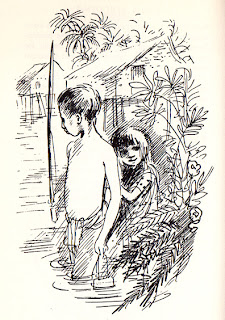 Indiana University which is located here in Bloomington, Indiana has a wonderful Fine Arts Library. I volunteer one day a week at the IU Art Museum which is connected to the Library. As part of my duties assisting the curator of the works on paper department, I'm often asked to do some research on a particular artist, painting, drawing or a photograph. On one of my recent afternoons in the library, I passed by the section on book illustrators and my eye caught sight of a book titled "Artists of a Certain Line, a Selection of Illustrators for Children's Books." Flipping through it I saw, as the title implies, that it was devoted to artists who work in pen and ink. After my work was done, I went back and decided to check it out on my library card.
Indiana University which is located here in Bloomington, Indiana has a wonderful Fine Arts Library. I volunteer one day a week at the IU Art Museum which is connected to the Library. As part of my duties assisting the curator of the works on paper department, I'm often asked to do some research on a particular artist, painting, drawing or a photograph. On one of my recent afternoons in the library, I passed by the section on book illustrators and my eye caught sight of a book titled "Artists of a Certain Line, a Selection of Illustrators for Children's Books." Flipping through it I saw, as the title implies, that it was devoted to artists who work in pen and ink. After my work was done, I went back and decided to check it out on my library card. It's a wonderful little book, published in London by The Bodley Head in 1960 and it is set-up as a brief survey of English artists (Maurice Sendak being the sole American) who at the time of the book's publication, were working in the field of children's book illustration. Some of the artists were familiar to me (Quentin Blake, Edward Ardizzone) but others were a happy discovery (Pearl Falconer, Peggy Fortnum). After having the book at home for a few days, I decided to check to see if the book was available anywhere to purchase. I managed to find an inexpensive used copy online and took the plunge and ordered it. It came in the mail today and it is in much better condition than the one that I just returned to the library.
I've scanned a few of my favorite images from the book to share in this blog with a little bit of information about the artists. By the way, the book has only one example of art per artist and though each example is accompanied by a short biography of the artist, unfortunately the artwork itself is not identified regarding its source.
The first artist in the book, which is arranged alphabetically, is Edward Ardizzone who was born in Haiphong, Tonkin, French Indo-China in 1900. Ardizzone is probably best known for his books featuring the maritime adventures of his character Tim (Little Tim and the Brave Sea Captain
Quentin Blake, born in 1932, is most famous for the eighteen Roald Dahl books that he has illustrated, but he has also written over 35 books of his own, including "Tell me a Picture
I was unable to find online, any biographical information on Pearl Falconer, but the book does tell us that she was born of Scottish parents and began to draw at a very early age. According to the book's short bio, she also painted covers for Harper's Bazaar for many years. I love the almost symmetrical composition of this image. The lamp post almost divides the composition down the middle, but it is placed off center just enough to prevent a perfect symmetry. With the dominant black shape of the older woman's dress, our eye is first drawn to the right side of the image before we jump across the vertical line of the post and then notice the black silhouettes of the two priests in the background. It's a very vertical composition, but the attention of the image is centered around the middle. I think it's a very clever use of a narrow image space.
The name Peggy Fortnum didn't ring any bells for me, but then I never grew up with the Paddington Bear books, for which she is most famous. She was born in 1919 and has illustrated around 65 books, including a version of "Reluctant Dragon."Like the rest of the images I've been discussing, I don't know what work this image is illustrating, but I think it's a wonderful piece. Judging from the palm trees in the background, the houses that appear to be on stilts, and the water that the children are venturing into, I would say it must be set somewhere in Indonesia or the South Pacific. You can almost sense the hesitancy on the part of the little girl in the image, you can tell she is happy to let the boy, who appears to be in native dress, go ahead of her.
When first seeing this amazing image by Robin Jacques (rhymes with 'cakes'), I was shocked to learn that he had no formal art training. He apparently taught himself to draw by copying images from anatomical books and from objects that he viewed in the Victoria and Albert Museum. Born in 1920, his major output in the world of children's illustration was between the 1940s and the 1980s. He illustrated a number of story collections put together by Ruth Manning-Sanders






No comments:
Post a Comment